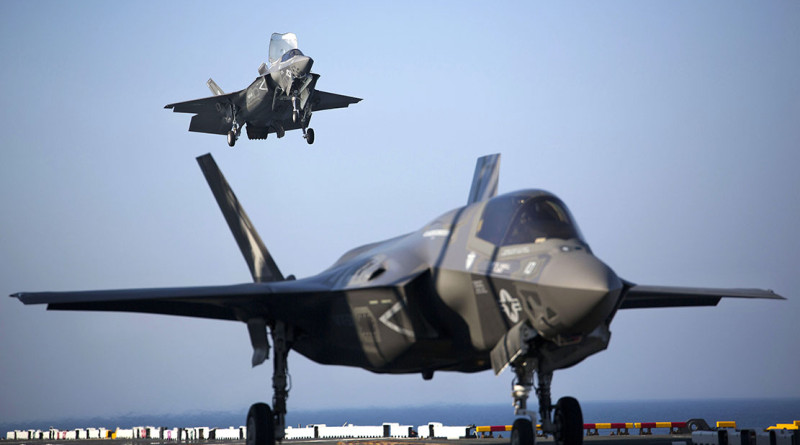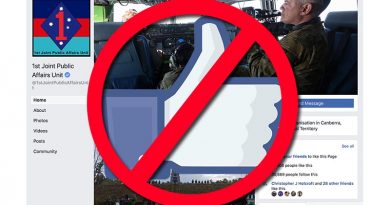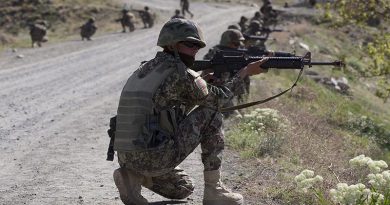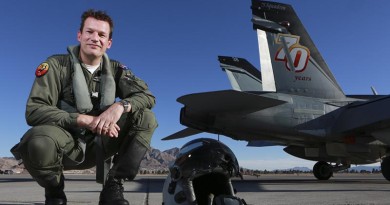US Marine Corps’ F-35B reached initial operational capability yesterday
Share the post "US Marine Corps’ F-35B reached initial operational capability yesterday"

The US Marine Corps’ F-35B Lightning II reached initial operational capability yesterday with a squadron of 10 F-35Bs ready for world-wide deployment.
Marine Fighter Attack Squadron 121 (VMFA-121), based in Yuma, Arizona, is the first squadron to become operational with an F-35 variant, following a five-day Operational Readiness Inspection (ORI), which concluded July 17.
General Joseph Dunford, Commandant of the Marine Corps, said he was pleased to announce that VMFA-121 has achieved Initial Operational Capability (IOC) in the F-35B.
“VMFA-121 has 10 aircraft in the Block 2B configuration with the requisite performance envelope and weapons clearances, to include the training, sustainment capabilities, and infrastructure to deploy to an austere site or a ship,” General Dunford said.
“It is capable of conducting close air support, offensive and defensive counter air, air interdiction, assault support escort and armed reconnaissance as part of a Marine Air Ground Task Force, or in support of the Joint Force.”
Lieutenant General Jon Davis, Deputy Commandant for Aviation, said the performance of the VMFA-121 during the ORI in all evaluated maintenance, flight operations, and exams was exceptional.
“The demonstrated capability of the squadron in the ORI, and in their run up to it, have given me the confidence that they meet our IOC criteria and, if required, could respond to a contingency.
“The performance of VMFA-121, and the entire F-35B team, has reinforced my feeling that we not only have great Marines in this program, but that we are giving them the right aircraft.
“If I have any concern at this point, it is that the spare parts available to extract maximum value from this exceptional warfighting asset will be shy of what we will truly need.
“In our legacy fleet, we resource our sustainment accounts in order to achieve between 70 and 75% readiness. I think we have that wrong, and I want to see if we can do better with this new platform.
“The F-35B has so much potential.
“I’ve asked my staff to see why we can’t resource this jet to achieve a significantly higher readiness rate.”
General Dunford said he has full confidence in the F-35B’s ability to support Marines in combat, predicated on years of concurrent developmental testing and operational flying.
“Prior to declaring IOC, we have conducted flight operations for seven weeks at sea aboard an L-Class carrier, participated in multiple large-force exercises and executed a recent operational evaluation which included multiple live ordnance sorties.
“The F-35B’s ability to conduct operations from expeditionary airstrips or sea-based carriers provides our nation with its first 5th generation strike fighter, which will transform the way we fight and win.”
As the future of Marine Corps tactical aviation, the F-35 will eventually replace three legacy platforms – the AV-8B Harrier, the F/A-18 Hornet, and the EA-6B Prowler.
“The success of VMFA-121 is a reflection of the hard work and effort by the Marines in the squadron, those involved in the program over many years, and the support we have received from across the Department of the Navy, the Joint Program Office, our industry partners, and the Under Secretary of Defense.
“Achieving IOC has truly been a team effort,” General Dunford said.
The US Marine Corps has trained and qualified more than 50 Marine F-35B pilots and certified about 500 maintenance personnel to assume autonomous, organic-level maintenance support for the F-35B.
VMFA-121’s transition will be followed by Marine Attack Squadron 211 (VMA-211), an AV-8B squadron, which is scheduled to transition to the F-35B in fiscal year 2016.
In 2018, Marine Fighter Attack Squadron 122 (VMFA-122), an F-18 Hornet squadron, will conduct its transition.
.
.

.
.
Share the post "US Marine Corps’ F-35B reached initial operational capability yesterday"






